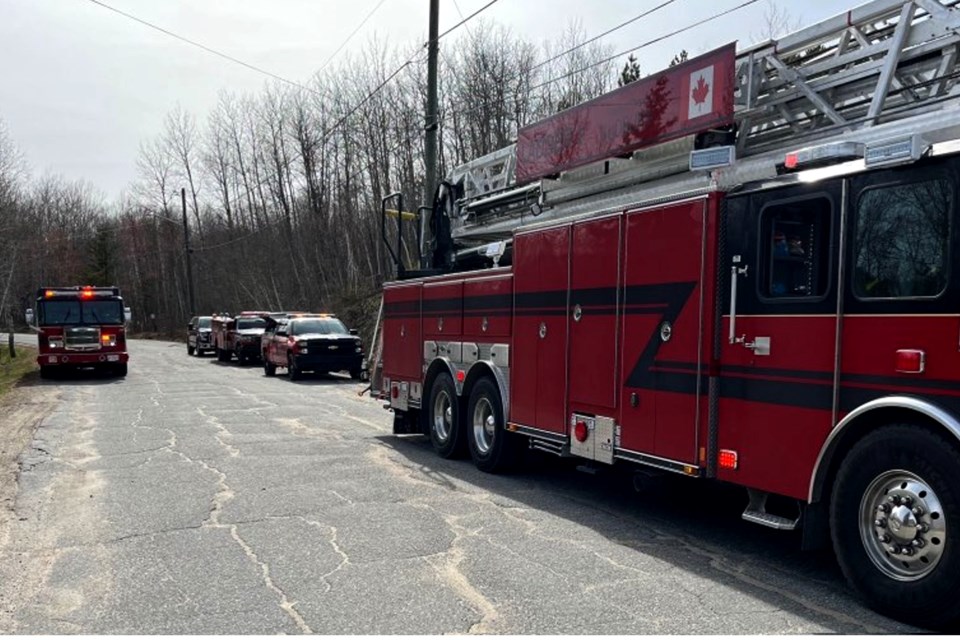A missing person case became an involved search and rescue operation in the Lake Laurentian Conservation area on May 9, when three-time author, athlete and former Laurentian University professor, 88-year-old Ronald Wallingford, went missing from his home.
Wallingford was located by Greater Sudbury Police and rescued by Greater Sudbury Fire Services after both water and high angle search and rescue techniques were employed.
Kaitlyn Dunn, spokesperson for Greater Sudbury Police, told Sudbury.com they received a call around 12:55 that Wallingford had disappeared from his home. A tweet from GSPS noted that they were focusing their search in the Laurentian Conservation area and were employing a drone, or Remotely Piloted Aircraft System (RPAS), to assist officers.
Wallingford was located by officers at approximately 3:30 p.m., at which point it was determined that a more intensive rescue operation would be required, and Greater Sudbury Fire Services were called in.
Deputy Chief Jesse Oshell told Sudbury.com that Wallingford was down a very steep embankment rock face, so steep that Oshell noted he was uncertain of how Wallingford even made it down to the area where he was found. Oshell described it as “a difficult-to-access area adjacent to Ramsey Lake, off Keast drive in the south end of Sudbury.”
Oshell said, to his knowledge, the location Wallingford was found in was approximately one kilometre “as the crow flies” from Wallingford’s residence. He said when found, Wallingford appeared to be dehydrated and fatigued, but in otherwise good health.
The rescue operation was conducted in an area he described as “very difficult, if not impossible, for the individual to get out of there on their own, without assistance.”
Oshell said Greater Sudbury Fire Services' technical rescuers, whether water or high angle, are always on duty. “They're always at the ready, so when we're called it's a very quick response, basically travel time to the location.”
Oshell said once on site, the rescue teams began planning to use both the water rescue team from the Ramsey Lake side to retrieve Wallingford from the water side. If that was unworkable, the high-angle rescue team was also in place to take him out that way.
Turns out, the high-angle worked best. “Our high-angle rescuers were able to attend, and develop a quick action plan,” said Oshell. “We safely created a rope system to go down with first responders, assess the individual, and then do what we call ‘packaging’ — we placed the individual in a specialized rescue basket secure for safety and we utilized our rope systems to remove the individual from the area.”
Though near the water, Oshell said the high-angle route was chosen as “sometimes, when we're dealing with the water situation, if there's not an area where we can get the boat right on shore, and as this was an elderly individual, we were unsure if we were going to be able to safely get them over the terrain and into the boat,” he said. “So we always do what's absolutely best and safest for the patient.”
After less than an hour, said Oshell, Wallingford was rescued, assessed by waiting paramedics and returned to his family.
Wallingford is known in Sudbury for his commitment to helping athletes achieve their goals, particularly those of Laurentian University students. Born in Ottawa in 1933, Wallingford had a storied athletic career as well as being a respected university professor in the School of Human Kinetics at Laurentian.
He captained the University of Michigan track team that won Big Ten Championships during the 1950s. Wallingford went on to hold the prestigious positions of the Canadian Track and Field Technical Coordinator and the Technical Director of Canadian Track and Field Association (CTFA), and served as director of the 1976 Montreal Olympic Marathon race.
For more than 20 years, Wallingford competed at Canada’s highest levels in events ranging from 1500m to the marathon and held Canada’s 3000m steeplechase record. He placed sixth in Canada at the 1966 Commonwealth Games, and competed in three Pan Am Games – Chicago (1959), Winnipeg (1967), and Cali (1971).
Twice he established Canadian fastest times ever for a marathon, including a third-place finish at the 1964 Boston Marathon with a time of two hours, 20 minutes and 51 seconds. This broke the Canadian fastest time for a marathon by more than two minutes and was the fourth fastest time ever recorded in this marathon over the official distance.
In 2002, Wallingford was inducted into the Laurentian University’s Hall of Fame as a ‘builder’. He was inducted as a member of the Sudbury Sports Hall of Fame in 2009. In 2020, he was named to his third hall of fame, when Athletics Ontario named him among five people inducted that year. In his time as a university professor, Wallingford dedicated his research to human hypothermia in cold water, exercise physiology as well as the physiological basis of human performance.
He is the author of three novels about track and field, Chasing the Olympic Dream, Portrait of a Runner and Never Let Go.
